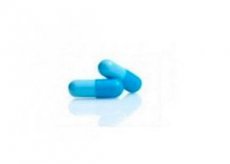Medical expert of the article
New publications
Preparations
Azidothymidine
Last reviewed: 03.07.2025

All iLive content is medically reviewed or fact checked to ensure as much factual accuracy as possible.
We have strict sourcing guidelines and only link to reputable media sites, academic research institutions and, whenever possible, medically peer reviewed studies. Note that the numbers in parentheses ([1], [2], etc.) are clickable links to these studies.
If you feel that any of our content is inaccurate, out-of-date, or otherwise questionable, please select it and press Ctrl + Enter.

Pharmacodynamics
The drug is phosphorylated inside the cell by cellular TK, thymidylate kinase, and along with this, non-specific kinase. As a result, certain phosphate compounds (mono-, di-, and tri-) are formed. The substance zidovudine triphosphate penetrates the structure of the provirus and prevents further increase in the viral DNA chain. As a result, the binding of parts of the viral DNA becomes impossible. The drug also helps to increase the number of T4 cells in the body.
Zidovudine is active against herpes viruses type 4, as well as hepatitis B in vitro tests. However, when used as a monotherapy in people with AIDS or hepatitis B, it does not significantly inhibit viral replication of hepatitis B.
In vitro, it was found that the substance in small concentrations can slow down the activity of most strains of enterobacteria (this includes strains of various types of salmonella, shigella, klebsiella, citrobacter and enterobacter), and along with this, E. coli (but it should be taken into account that microbes quickly acquire resistance to zidovudine).
In vitro tests failed to reveal the substance's activity against Pseudomonas aeruginosa. The drug in high concentrations (1.9 μg/ml) inhibits intestinal lamblia, but has no effect on other protozoa.
Pharmacokinetics
The bioavailability level of the substance is 60–70%.
The drug penetrates the BBB. The concentration index in the cerebrospinal fluid reaches 50% of the plasma values of the substance. It is subject to hepatic metabolism.
Excretion occurs through the kidneys - approximately 30% of the drug is excreted unchanged, and another 50+% is in the form of glucuronides.
 [ 15 ], [ 16 ], [ 17 ], [ 18 ], [ 19 ], [ 20 ], [ 21 ], [ 22 ]
[ 15 ], [ 16 ], [ 17 ], [ 18 ], [ 19 ], [ 20 ], [ 21 ], [ 22 ]
Dosing and administration
Oral administration. For adults, the initial dosage is 200 mg of the drug 6 times a day. The most suitable daily dosage is selected individually, it can range from 500-1500 mg.
For children: on average, the dosage is calculated within 150-180 mg/ m2 every 6 hours (four times a day). Dosages are recalculated in accordance with special tables that take into account weight and height. This must be done at least once every 2 months.
Use Azidothymidine during pregnancy
The drug can be used during pregnancy, but only if the benefit from taking it is higher than the likelihood of complications in the fetus.
During the period of using Azidothymidine, it is necessary to stop breastfeeding.
Side effects Azidothymidine
The use of the drug may cause the occurrence of certain side effects:
- development of anemia, neutro- or leukopenia;
- the appearance of headaches, a feeling of drowsiness, paresthesia, severe fatigue, asthenia, myalgia with cardialgia, as well as a disorder of taste buds;
- the occurrence of diarrhea, vomiting, bloating and nausea, as well as the development of gastralgia or pancreatitis and loss of appetite;
- the occurrence of a secondary infection and the development of fever;
- the appearance of cough, insomnia, chills, increased frequency of urination, development of depression;
- development of dyspeptic manifestations or hypercreatininemia, as well as an increase in the activity of liver transaminases and amylase in the serum.
Interactions with other drugs
Paracetamol increases the incidence of neutropenia because this substance inhibits the metabolism of zidovudine (both drugs undergo glucuronidation).
Inhibitors of oxidative processes of microsomes inside the liver (among them morphine with oxazepam, codeine, ASA and clofibrate, as well as indomethacin with cimetidine) increase plasma values of zidovudine.
Medicines that have nephrotoxic properties, as well as those that suppress bone marrow function (such as amphotericin, vinblastine with ganciclovir and pentamidine, as well as vincristine), increase the likelihood of zidovudine developing a toxic effect.
Drugs that inhibit tubular secretion prolong the half-life of zidovudine.
Zidovudine increases the level of fluconazole in the body.
When combined with other drugs against the HIV virus (especially lamivudine), a synergistic effect occurs with respect to the replication of HIV infection in cell culture.
Ribavirin inhibits the phosphorylation of zidovudine to form triphosphate, so these drugs cannot be used in combination.
Stavudine has antagonistic properties when the molar values of this substance with zidovudine have a proportion of 20:1. As a result, the combination with stavudine is prohibited.
Attention!
To simplify the perception of information, this instruction for use of the drug "Azidothymidine" translated and presented in a special form on the basis of the official instructions for medical use of the drug. Before use read the annotation that came directly to medicines.
Description provided for informational purposes and is not a guide to self-healing. The need for this drug, the purpose of the treatment regimen, methods and dose of the drug is determined solely by the attending physician. Self-medication is dangerous for your health.

